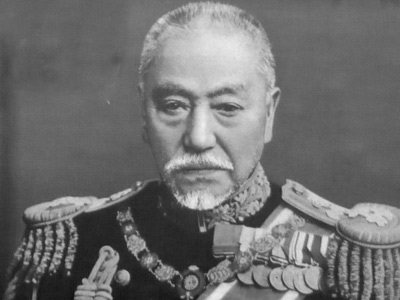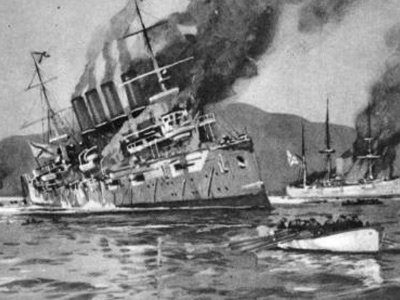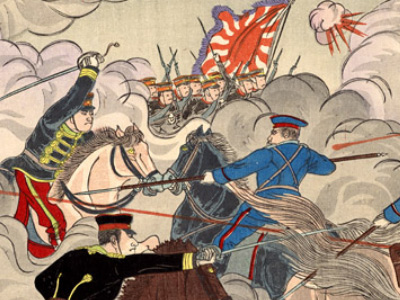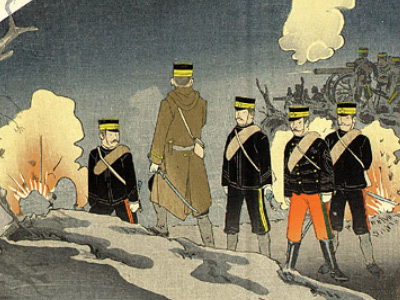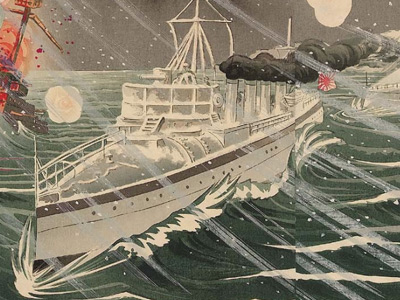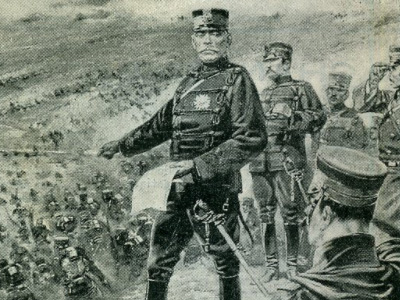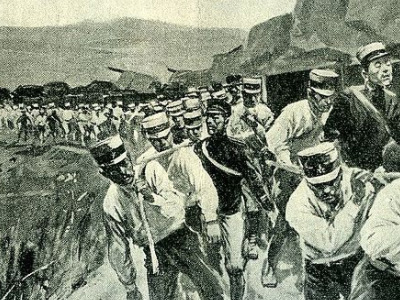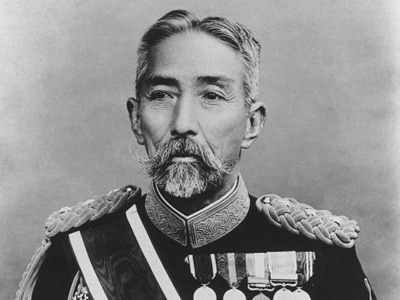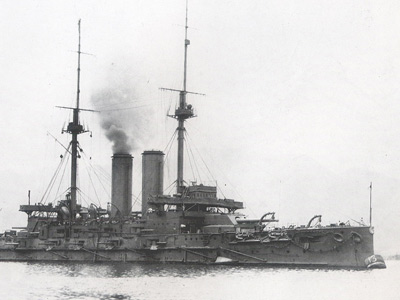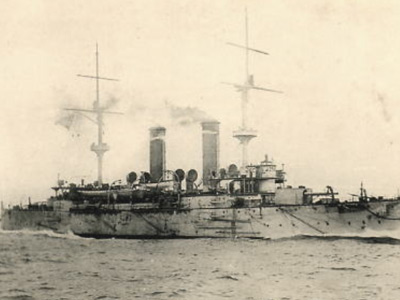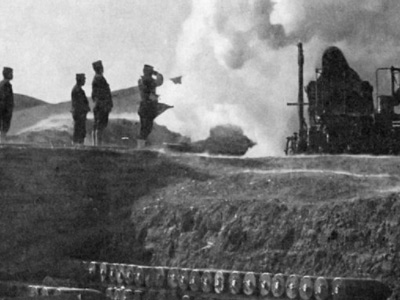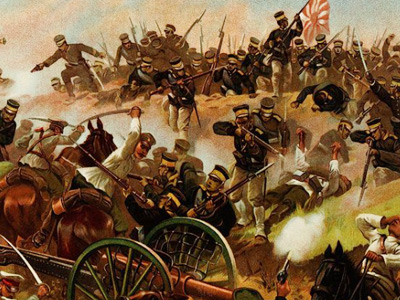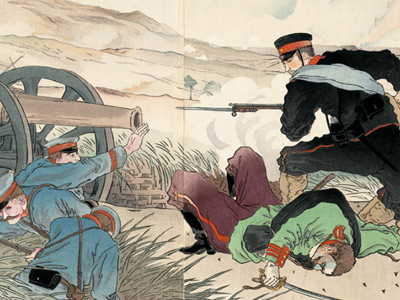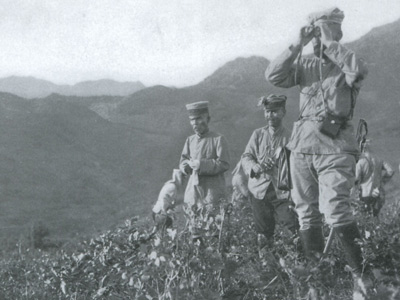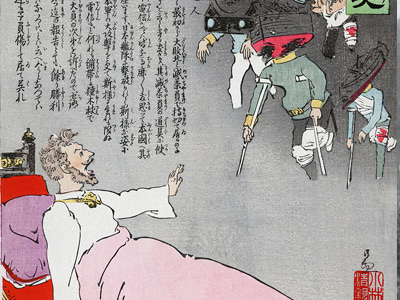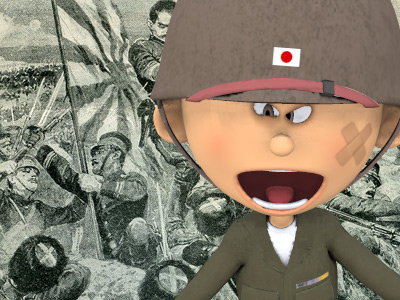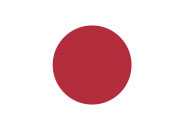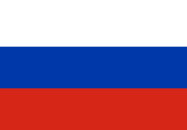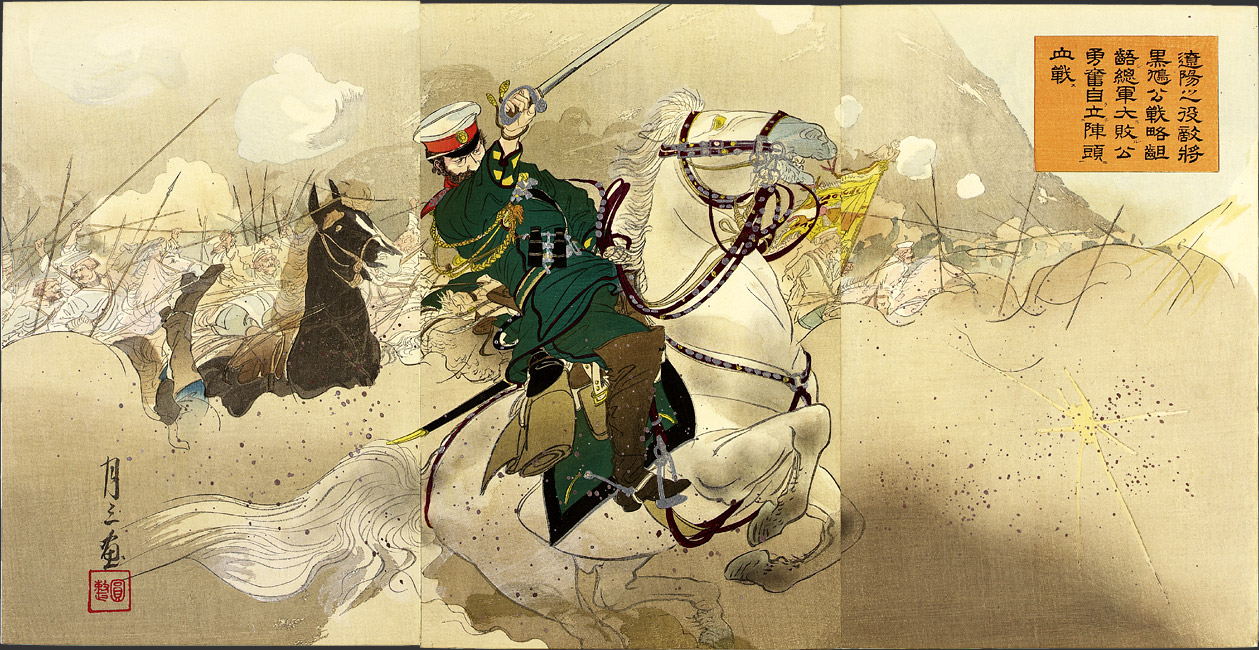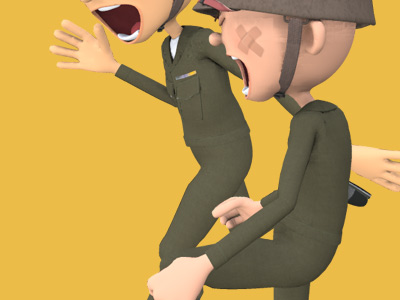Russo-Japanese War (1904–1905)
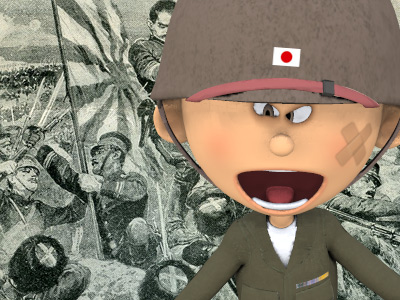
Historical Background
In 1853 Commodore Perry of the US Navy arrived in Japan and brought an end to Japan's policy of self-isolation by forcing the Tokugawa shogunate to sign the Convention of Kanagawa the following year. This encounter with a modern Western power served to portray the West as having a confrontational and imperialist political agenda, which Japan The Empire of Japan, also known as the Japanese Empire or Imperial Japan, was a historical nation-state and great power that existed from the Meiji Restoration in 1868 until the enactment of the post-World War II 1947 constitution and subsequent formation of modern Japan. Economic and political turmoil in the 1920s led to the rise of militarism, nationalism and totalitarianism eventually culminating in Japan's membership in the Axis alliance. viewed with respect through World War II
The Empire of Japan, also known as the Japanese Empire or Imperial Japan, was a historical nation-state and great power that existed from the Meiji Restoration in 1868 until the enactment of the post-World War II 1947 constitution and subsequent formation of modern Japan. Economic and political turmoil in the 1920s led to the rise of militarism, nationalism and totalitarianism eventually culminating in Japan's membership in the Axis alliance. viewed with respect through World War II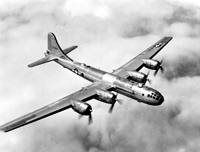 World War II or the Second World War, often abbreviated as WWII or WW2, was a world war that lasted from 1939 to 1945. It involved the vast majority of the world's countries—including all of the great powers—forming two opposing military alliances: the Allies and the Axis powers. World War II was a total war that directly involved more than 100 million personnel from more than 30 countries. World War II is generally considered to have begun on 1 September 1939, when Nazi Germany, under Adolf Hitler, invaded Poland. View World War II ». Japan sought to maintain its autonomy and resisted colonialism by Western nations. The Meiji Restoration in 1868 served as an early Japanese response to the challenges of the modern world.
World War II or the Second World War, often abbreviated as WWII or WW2, was a world war that lasted from 1939 to 1945. It involved the vast majority of the world's countries—including all of the great powers—forming two opposing military alliances: the Allies and the Axis powers. World War II was a total war that directly involved more than 100 million personnel from more than 30 countries. World War II is generally considered to have begun on 1 September 1939, when Nazi Germany, under Adolf Hitler, invaded Poland. View World War II ». Japan sought to maintain its autonomy and resisted colonialism by Western nations. The Meiji Restoration in 1868 served as an early Japanese response to the challenges of the modern world.
After the Meiji Restoration in 1868, the Meiji government endeavored to assimilate Western ideas, technological advances and customs. By the late 19th century, Japan had transformed itself into a modernized industrial state. The Japanese wanted to preserve their sovereignty and be recognized as equal with the Western powers.
Tsarist Russia, as a major imperial power, had ambitions in the East. By the 1890s it had extended its realm across Central Asia to Afghanistan, absorbing local states in the process. The Russian Empire Russian Empire was an empire and the final period of the Russian monarchy from 1721 to 1917, ruling across large parts of Eurasia. The rise of the Russian Empire coincided with the decline of neighbouring rival powers: the Swedish Empire, the Polish–Lithuanian Commonwealth, Qajar Iran, the Ottoman Empire, and Qing China. Russia remains the third-largest empire in history, surpassed only by the British Empire and the Mongol Empire. stretched from Poland
Russian Empire was an empire and the final period of the Russian monarchy from 1721 to 1917, ruling across large parts of Eurasia. The rise of the Russian Empire coincided with the decline of neighbouring rival powers: the Swedish Empire, the Polish–Lithuanian Commonwealth, Qajar Iran, the Ottoman Empire, and Qing China. Russia remains the third-largest empire in history, surpassed only by the British Empire and the Mongol Empire. stretched from Poland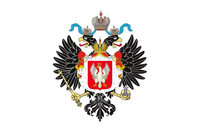 Congress Poland, Congress Kingdom of Poland, or Russian Poland, formally known as the Kingdom of Poland, was a polity created in 1815 by the Congress of Vienna as a semi-autonomous Polish state, a successor to Napoleon's Duchy of Warsaw. It was established when the French ceded a part of Polish territory to the Russian Empire following France's defeat in the Napoleonic Wars. In 1915, during World War I, it was replaced by the German-controlled nominal Regency Kingdom until Poland regained independence in 1918. in the west to the Kamchatka Peninsula in the east. With its construction of the Trans-Siberian Railway to the port of Vladivostok, Russia hoped to further consolidate its influence and presence in the region. In the Tsushima incident of 1861 Russia had directly assaulted Japanese territory. Fearing Russian expansion, Japan regarded Korea (and to a lesser extent Manchuria) as a protective buffer.
Congress Poland, Congress Kingdom of Poland, or Russian Poland, formally known as the Kingdom of Poland, was a polity created in 1815 by the Congress of Vienna as a semi-autonomous Polish state, a successor to Napoleon's Duchy of Warsaw. It was established when the French ceded a part of Polish territory to the Russian Empire following France's defeat in the Napoleonic Wars. In 1915, during World War I, it was replaced by the German-controlled nominal Regency Kingdom until Poland regained independence in 1918. in the west to the Kamchatka Peninsula in the east. With its construction of the Trans-Siberian Railway to the port of Vladivostok, Russia hoped to further consolidate its influence and presence in the region. In the Tsushima incident of 1861 Russia had directly assaulted Japanese territory. Fearing Russian expansion, Japan regarded Korea (and to a lesser extent Manchuria) as a protective buffer.

These books are available for download with Apple Books on your Mac or iOS device
Sino-Japanese War (1894–95)
Between the Meiji Restoration and its participation in World War I World War I, also known as the First World War, or the Great War, was a global war originating in Europe that lasted from 28 July 1914 to 11 November 1918. More than 70 million military personnel, including 60 million Europeans, were mobilized in one of the largest wars in history. The war drew in all the world's economic great powers, assembled in two opposing alliances: the Allies versus the Central Powers of Germany and Austria-Hungary. View World War I », the Empire of Japan fought in two significant wars. The first war Japan fought was the First Sino-Japanese War, fought in 1894 and 1895. The war revolved around the issue of control and influence over Korea under the rule of the Joseon dynasty. From the 1880s onward, there had been vigorous competition for influence in Korea between China and Japan. The Korean court was prone to factionalism, and was badly divided by a reformist faction that was pro-Japanese and a more conservative faction that was pro-Chinese. In 1884, a pro-Japanese coup attempt was put down by Chinese troops, and a "residency" under General Yuan Shikai was established in Seoul. A peasant rebellion led by the Tonghak religious movement led to a request by the Korean government for the Qing dynasty to send in troops to stabilize the country. The Empire of Japan responded by sending their own force to Korea to crush the Tonghak and installed a puppet government in Seoul. China objected and war ensued. Hostilities proved brief, with Japanese ground troops routing Chinese forces on the Liaodong Peninsula and nearly destroying the Chinese Navy in the Battle of the Yalu River. Japan and China signed the Treaty of Shimonoseki, which ceded the Liaodong Peninsula and the island of Taiwan to Japan.
World War I, also known as the First World War, or the Great War, was a global war originating in Europe that lasted from 28 July 1914 to 11 November 1918. More than 70 million military personnel, including 60 million Europeans, were mobilized in one of the largest wars in history. The war drew in all the world's economic great powers, assembled in two opposing alliances: the Allies versus the Central Powers of Germany and Austria-Hungary. View World War I », the Empire of Japan fought in two significant wars. The first war Japan fought was the First Sino-Japanese War, fought in 1894 and 1895. The war revolved around the issue of control and influence over Korea under the rule of the Joseon dynasty. From the 1880s onward, there had been vigorous competition for influence in Korea between China and Japan. The Korean court was prone to factionalism, and was badly divided by a reformist faction that was pro-Japanese and a more conservative faction that was pro-Chinese. In 1884, a pro-Japanese coup attempt was put down by Chinese troops, and a "residency" under General Yuan Shikai was established in Seoul. A peasant rebellion led by the Tonghak religious movement led to a request by the Korean government for the Qing dynasty to send in troops to stabilize the country. The Empire of Japan responded by sending their own force to Korea to crush the Tonghak and installed a puppet government in Seoul. China objected and war ensued. Hostilities proved brief, with Japanese ground troops routing Chinese forces on the Liaodong Peninsula and nearly destroying the Chinese Navy in the Battle of the Yalu River. Japan and China signed the Treaty of Shimonoseki, which ceded the Liaodong Peninsula and the island of Taiwan to Japan.

Illustration of Chinese Generals from Pyongyang Captured Alive by Migita Toshihide, October 1894. Collection of Museum of Fine Arts, Boston

Illustration of Chinese Generals from Pyongyang Captured Alive by Migita Toshihide, October 1894. Collection of Museum of Fine Arts, Boston
( Click image to enlarge)
After the peace treaty, Russia, Germany The German Empire, also referred to as Imperial Germany, the Second Reich, as well as simply Germany, was the period of the German Reich from the unification of Germany in 1871 until the November Revolution in 1918, when the German Reich changed its form of government from a monarchy to a republic. During its 47 years of existence, the German Empire became the industrial, technological, and scientific giant of Europe., and France
The German Empire, also referred to as Imperial Germany, the Second Reich, as well as simply Germany, was the period of the German Reich from the unification of Germany in 1871 until the November Revolution in 1918, when the German Reich changed its form of government from a monarchy to a republic. During its 47 years of existence, the German Empire became the industrial, technological, and scientific giant of Europe., and France French Third Republic was the system of government adopted in France from 4 September 1870, when the Second French Empire collapsed during the Franco-Prussian War, until 10 July 1940, after the Fall of France during World War II led to the formation of the Vichy government. During the 19th and 20th centuries, the French colonial empire was the second largest colonial empire in the world only behind the British Empire. forced Japan to withdraw from the Liaodong Peninsula. The leaders of Japan did not feel that they possessed the strength to resist the combined might of Russia, Germany and France, and so gave in to the ultimatum. At the same time, the Japanese did not abandon their attempts to force Korea into the Japanese sphere of influence. On 8 October 1895, Queen Min of Korea, the leader of the anti-Japanese and pro-Chinese faction at the Korean court was murdered by Japanese agents within the halls of the Gyeongbokgung palace, an act that backfired badly as it turned Korean public opinion against Japan. In early 1896, King Gojong of Korea fled to the Russian legation in Seoul under the grounds that his life was in danger from Japanese agents, and Russian influence in Korea started to predominate. In the aftermath of the flight of the king, a popular uprising overthrew the pro-Japanese government and several cabinet ministers were lynched on the streets.
French Third Republic was the system of government adopted in France from 4 September 1870, when the Second French Empire collapsed during the Franco-Prussian War, until 10 July 1940, after the Fall of France during World War II led to the formation of the Vichy government. During the 19th and 20th centuries, the French colonial empire was the second largest colonial empire in the world only behind the British Empire. forced Japan to withdraw from the Liaodong Peninsula. The leaders of Japan did not feel that they possessed the strength to resist the combined might of Russia, Germany and France, and so gave in to the ultimatum. At the same time, the Japanese did not abandon their attempts to force Korea into the Japanese sphere of influence. On 8 October 1895, Queen Min of Korea, the leader of the anti-Japanese and pro-Chinese faction at the Korean court was murdered by Japanese agents within the halls of the Gyeongbokgung palace, an act that backfired badly as it turned Korean public opinion against Japan. In early 1896, King Gojong of Korea fled to the Russian legation in Seoul under the grounds that his life was in danger from Japanese agents, and Russian influence in Korea started to predominate. In the aftermath of the flight of the king, a popular uprising overthrew the pro-Japanese government and several cabinet ministers were lynched on the streets.
In 1897, Russia occupied the Liaodong Peninsula, built the Port Arthur fortress, and based the Russian Pacific Fleet in the port. Russia's acquisition of Port Arthur was primarily an anti-British move to counter the British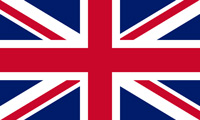 The United Kingdom of Great Britain and Ireland was a sovereign state in Northwestern Europe that comprised the entirety of the British Isles between 1801 and 1922. The United Kingdom, having financed the European coalition that defeated France during the Napoleonic Wars, developed a large Royal Navy that enabled the British Empire to become the foremost world power for the next century. occupation of Wei-hai-Wei, but in Japan, this was perceived as an anti-Japanese move. Germany occupied Jiaozhou Bay, built the Tsingtao fortress, and based the German East Asia Squadron in this port. Between 1897–1903, the Russians built the Chinese Eastern Railway (CER) in Manchuria. The Chinese Eastern Railroad was owned jointly by the Russian and Chinese governments, but the company's management was entirely Russian, the line was built to the Russian gauge and Russian troops were stationed in Manchuria to protect rail traffic on the CER from bandit attacks. The headquarters of the CER company was located in the new Russian-built city of Harbin, the "Moscow of the Orient". From 1897 onwards, Manchuria—while still nominally part of the "Great Qing Empire"—started to resemble more and more a Russian province.
The United Kingdom of Great Britain and Ireland was a sovereign state in Northwestern Europe that comprised the entirety of the British Isles between 1801 and 1922. The United Kingdom, having financed the European coalition that defeated France during the Napoleonic Wars, developed a large Royal Navy that enabled the British Empire to become the foremost world power for the next century. occupation of Wei-hai-Wei, but in Japan, this was perceived as an anti-Japanese move. Germany occupied Jiaozhou Bay, built the Tsingtao fortress, and based the German East Asia Squadron in this port. Between 1897–1903, the Russians built the Chinese Eastern Railway (CER) in Manchuria. The Chinese Eastern Railroad was owned jointly by the Russian and Chinese governments, but the company's management was entirely Russian, the line was built to the Russian gauge and Russian troops were stationed in Manchuria to protect rail traffic on the CER from bandit attacks. The headquarters of the CER company was located in the new Russian-built city of Harbin, the "Moscow of the Orient". From 1897 onwards, Manchuria—while still nominally part of the "Great Qing Empire"—started to resemble more and more a Russian province.
Russian Encroachment
In December 1897 a Russian fleet appeared off Port Arthur. After three months, in 1898, China and Russia negotiated a convention by which China leased (to Russia) Port Arthur, Talienwan and the surrounding waters. The two parties further agreed that the convention could be extended by mutual agreement. The Russians clearly expected such an extension, for they lost no time in occupying the territory and in fortifying Port Arthur, their sole warm-water port on the Pacific coast and of great strategic value. A year later, to consolidate their position, the Russians began to build a new railway from Harbin through Mukden to Port Arthur, the South Manchurian Railroad. The development of the railway became a contributory factor to the Boxer Rebellion, when Boxer forces burned the railway stations.
The Russians also began to make inroads into Korea. By 1898 they had acquired mining and forestry concessions near the Yalu and Tumen rivers, causing the Japanese much anxiety. Japan decided to attack before the Russians completed the Trans-Siberian Railway.
Boxer Rebellion
The Russians and the Japanese both contributed troops to the eight-member international force sent in 1900 to quell the Boxer Rebellion and to relieve the international legations under siege in the Chinese capital, Beijing. Russia had already sent 177,000 soldiers to Manchuria, nominally to protect its railways under construction. The troops of the Qing Empire and the participants of the Boxer Rebellion could do nothing against such a massive army and were ejected from Manchuria. After the Boxer Rebellion, 100,000 Russian soldiers were stationed in Manchuria. The Russian troops settled in and despite assurances they would vacate the area after the crisis, by 1903 the Russians had not established a timetable for withdrawal and had actually strengthened their position in Manchuria.
HISTORY
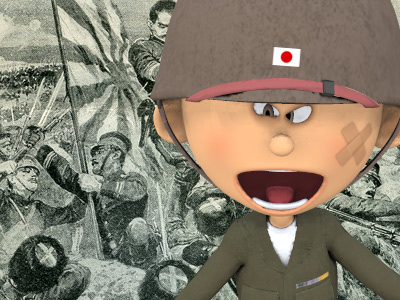
RESOURCES
This article uses material from the Wikipedia article "Russo-Japanese War", which is released under the Creative Commons Attribution-Share-Alike License 3.0.
© Stories Preschool. All Rights Reserved.
